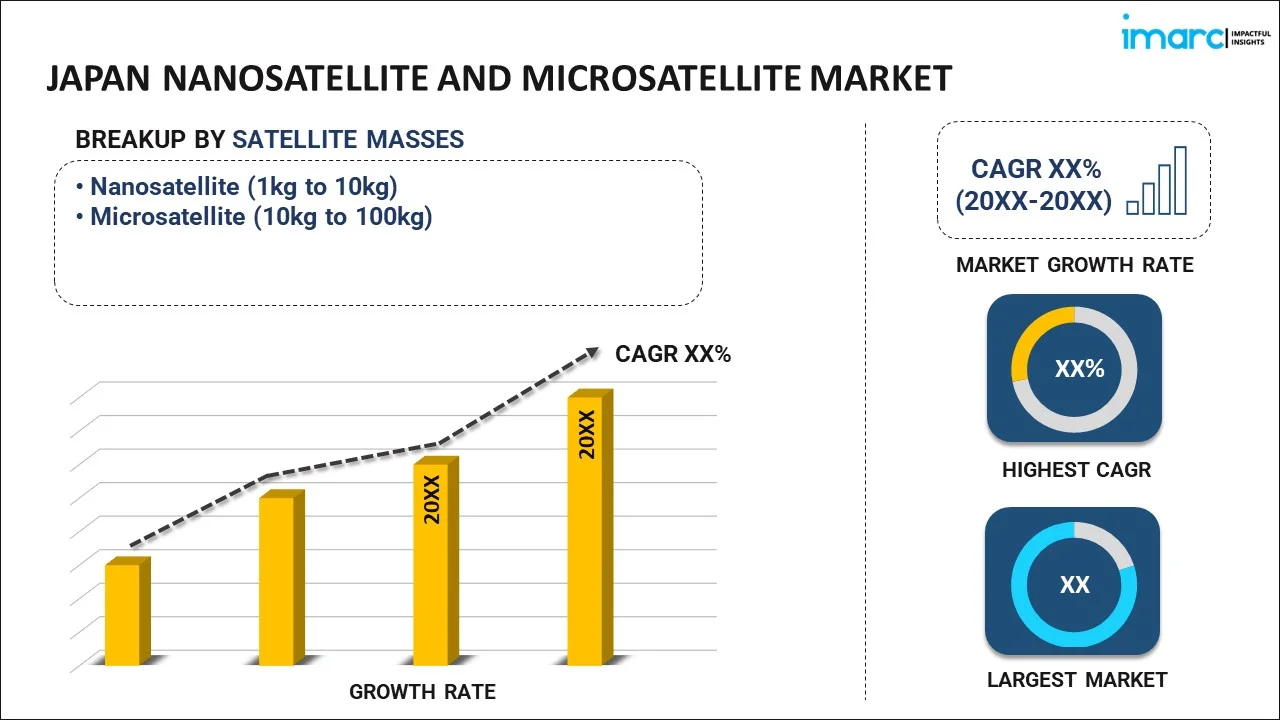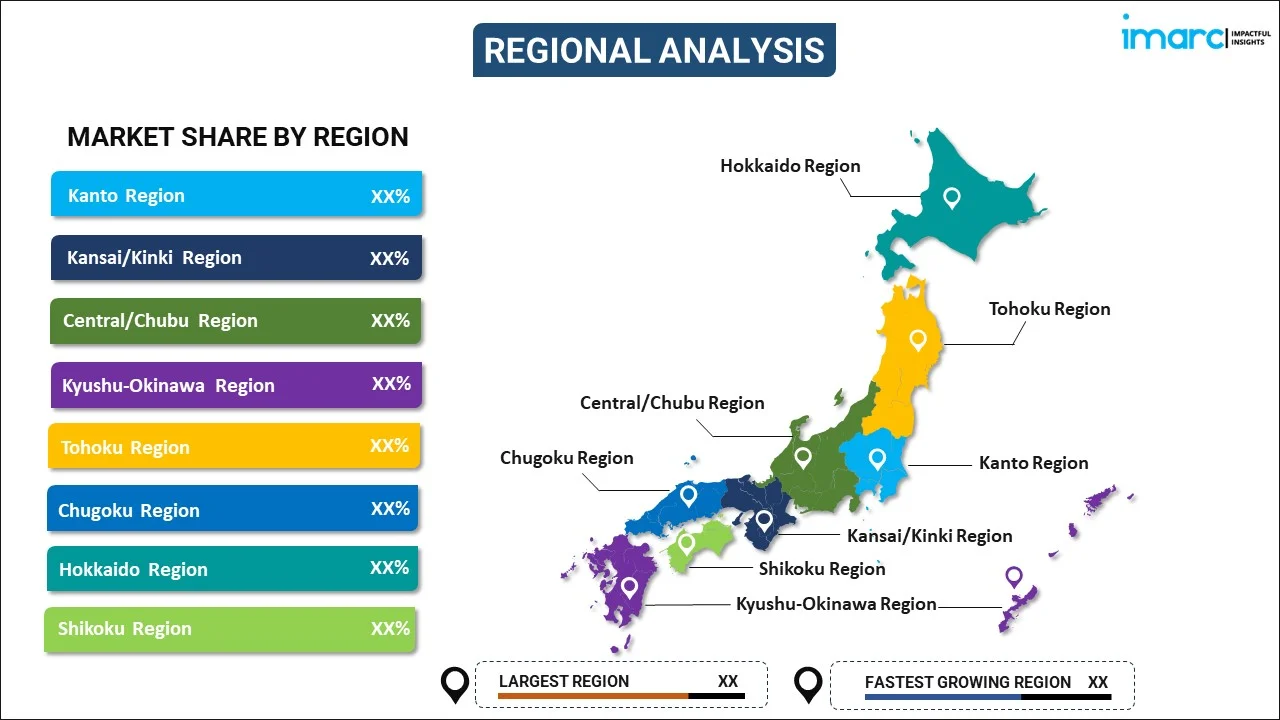
Japan Nanosatellite and Microsatellite Market Report by Satellite Mass (Nanosatellite (1kg to 10kg), Microsatellite (10kg to 100kg)), Component (Hardware, Software, Space Services, Launch Services), Application (Communication, Earth Observation and Remote Sensing, Scientific Research, Biological Experiments, Technology Demonstration and Verification, Academic Training, Mapping and Navigation, Reconnaissance, and Others), End Use Sector (Government, Civil, Commercial, Defense, Energy and Infrastructure, and Others), and Region 2025-2033
Market Overview:
Japan nanosatellite and microsatellite market size reached USD 150.5 Million in 2024. Looking forward, IMARC Group expects the market to reach USD 998.6 Million by 2033, exhibiting a growth rate (CAGR) of 21.4% during 2025-2033. The market is being driven by several significant factors, including a heightened need for Earth observation, the expanding adoption of IoT connectivity, the increasing commercialization of the space industry, and ongoing technological advancements.
|
Report Attribute
|
Key Statistics
|
|---|---|
|
Base Year
|
2024
|
|
Forecast Years
|
2025-2033
|
|
Historical Years
|
2019-2024
|
|
Market Size in 2024
|
USD 150.5 Million |
|
Market Forecast in 2033
|
USD 998.6 Million |
| Market Growth Rate 2025-2033 | 21.4% |
Nanosatellites, commonly referred to as CubeSats, are diminutive satellites with mass falling within the 1 to 10-kilogram range. They typically exhibit a cubic configuration, with each side measuring 10 centimeters. Despite their compact dimensions, nanosatellites incorporate various subsystems, such as power systems, communication systems, and onboard computers, enabling them to execute specific space missions. In contrast, microsatellites, which are slightly larger than nanosatellites, possess a mass ranging from 10 to 100 kilograms. Due to their increased size and payload capacity, microsatellites offer enhanced capabilities compared to nanosatellites. They find applications in tasks such as Earth observation, remote sensing, and communication, thanks to their ability to accommodate more advanced instruments and sensors, resulting in higher-resolution data acquisition and transmission. Both nanosatellites and microsatellites bring numerous advantages over conventional larger satellites, including cost-effectiveness, quicker development timelines, and the potential for launching multiple satellites concurrently. Their compact size also simplifies deployment and integration into existing satellite constellations. Consequently, these small-scale satellites have garnered substantial popularity in recent years, contributing significantly to the growth and innovation within the space industry.
Japan Nanosatellite and Microsatellite Market Trends:
The nanosatellite and microsatellite market in Japan is witnessing substantial growth and innovation, reflecting the nation's commitment to space exploration and satellite technology. Nanosatellites are playing a crucial role in Japan's space endeavors, often utilized for scientific research, Earth observation, and technology demonstration missions. Their compact size and relatively low development costs have made them an attractive option for universities, research institutions, and private companies to engage in space-based projects. Additionally, Japanese organizations have leveraged microsatellites to enhance national security, disaster management, and environmental monitoring efforts, which is acting as another significant growth-inducing factor. Japan's continued investment in nanosatellite and microsatellite technology, coupled with its growing commercial space industry, is driving market growth. Besides this, the nation's space agencies and private companies are collaborating on various missions, contributing to the development of advanced sensors, communication systems, and propulsion technologies for small satellites. All these factors are projected to fuel the regional market in the coming years.
Japan Nanosatellite and Microsatellite Market Segmentation:
IMARC Group provides an analysis of the key trends in each segment of the market, along with forecasts at the country level for 2025-2033. Our report has categorized the market based on satellite mass, component, application, and end use sector.
Satellite Mass Insights:

- Nanosatellite (1kg to 10kg)
- Microsatellite (10kg to 100kg)
The report has provided a detailed breakup and analysis of the market based on the satellite mass. This includes nanosatellite (1kg to 10kg) and microsatellite (10kg to 100kg).
Component Insights:
- Hardware
- Software
- Space Services
- Launch Services
A detailed breakup and analysis of the market based on the component have also been provided in the report. This includes hardware, software, space services, and launch services.
Application Insights:
- Communication
- Earth Observation and Remote Sensing
- Scientific Research
- Biological Experiments
- Technology Demonstration and Verification
- Academic Training
- Mapping and Navigation
- Reconnaissance
- Others
The report has provided a detailed breakup and analysis of the market based on the application. This includes communication, earth observation and remote sensing, scientific research, biological experiments, technology demonstration and verification, academic training, mapping and navigation, reconnaissance, and others.
End Use Sector Insights:
- Government
- Civil
- Commercial
- Defense
- Energy and Infrastructure
- Others
A detailed breakup and analysis of the market based on the end use sector have also been provided in the report. This includes government, civil, commercial, defense, energy and infrastructure, and others.
Regional Insights:

- Kanto Region
- Kansai/Kinki Region
- Central/ Chubu Region
- Kyushu-Okinawa Region
- Tohoku Region
- Chugoku Region
- Hokkaido Region
- Shikoku Region
The report has also provided a comprehensive analysis of all the major regional markets, which include Kanto Region, Kansai/Kinki Region, Central/ Chubu Region, Kyushu-Okinawa Region, Tohoku Region, Chugoku Region, Hokkaido Region, and Shikoku Region.
Competitive Landscape:
The market research report has also provided a comprehensive analysis of the competitive landscape. Competitive analysis such as market structure, key player positioning, top winning strategies, competitive dashboard, and company evaluation quadrant has been covered in the report. Also, detailed profiles of all major companies have been provided.
Japan Nanosatellite and Microsatellite Market Report Coverage:
| Report Features | Details |
|---|---|
| Base Year of the Analysis | 2024 |
| Historical Period | 2019-2024 |
| Forecast Period | 2025-2033 |
| Units | Million USD |
| Scope of the Report | Exploration of Historical and Forecast Trends, Industry Catalysts and Challenges, Segment-Wise Historical and Predictive Market Assessment:
|
| Satellite Masses Covered | Nanosatellite (1kg to 10kg), Microsatellite (10kg to 100kg) |
| Components Covered | Hardware, Software, Space Services, Launch Services |
| Applications Covered | Communication, Earth Observation and Remote Sensing, Scientific Research, Biological Experiments, Technology Demonstration and Verification, Academic Training, Mapping and Navigation, Reconnaissance, Others |
| End Use Sectors Covered | Government, Civil, Commercial, Defense, Energy and Infrastructure, Others |
| Regions Covered | Kanto Region, Kansai/Kinki Region, Central/ Chubu Region, Kyushu-Okinawa Region, Tohoku Region, Chugoku Region, Hokkaido Region, Shikoku Region |
| Customization Scope | 10% Free Customization |
| Post-Sale Analyst Support | 10-12 Weeks |
| Delivery Format | PDF and Excel through Email (We can also provide the editable version of the report in PPT/Word format on special request) |
Key Questions Answered in This Report:
- How has the Japan nanosatellite and microsatellite market performed so far and how will it perform in the coming years?
- What has been the impact of COVID-19 on the Japan nanosatellite and microsatellite market?
- What is the breakup of the Japan nanosatellite and microsatellite market on the basis of satellite mass?
- What is the breakup of the Japan nanosatellite and microsatellite market on the basis of component?
- What is the breakup of the Japan nanosatellite and microsatellite market on the basis of application?
- What is the breakup of the Japan nanosatellite and microsatellite market on the basis of end use sector?
- What are the various stages in the value chain of the Japan nanosatellite and microsatellite market?
- What are the key driving factors and challenges in the Japan nanosatellite and microsatellite?
- What is the structure of the Japan nanosatellite and microsatellite market and who are the key players?
- What is the degree of competition in the Japan nanosatellite and microsatellite market?
Key Benefits for Stakeholders:
- IMARC’s industry report offers a comprehensive quantitative analysis of various market segments, historical and current market trends, market forecasts, and dynamics of the Japan nanosatellite and microsatellite market from 2019-2033.
- The research report provides the latest information on the market drivers, challenges, and opportunities in the Japan nanosatellite and microsatellite market.
- Porter's five forces analysis assist stakeholders in assessing the impact of new entrants, competitive rivalry, supplier power, buyer power, and the threat of substitution. It helps stakeholders to analyze the level of competition within the Japan nanosatellite and microsatellite industry and its attractiveness.
- Competitive landscape allows stakeholders to understand their competitive environment and provides an insight into the current positions of key players in the market.
Need more help?
- Speak to our experienced analysts for insights on the current market scenarios.
- Include additional segments and countries to customize the report as per your requirement.
- Gain an unparalleled competitive advantage in your domain by understanding how to utilize the report and positively impacting your operations and revenue.
- For further assistance, please connect with our analysts.
 Inquire Before Buying
Inquire Before Buying
 Speak to an Analyst
Speak to an Analyst
 Request Brochure
Request Brochure
 Request Customization
Request Customization




.webp)




.webp)












